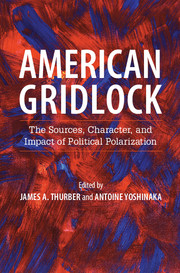Book contents
- Frontmatter
- Dedication
- Contents
- List of contributors
- Foreword
- Acknowledgments
- Introduction
- PART I POLARIZATION AMONG VOTERS AND ACTIVISTS
- PART II POLARIZATION IN NATIONAL INSTITUTIONS
- PART III POLARIZATION IN THE STATES
- PART IV POLARIZATION IN THE MEDIA
- 12 Partisan Media and Electoral Polarization in 2012: Evidence from the American National Election Study
- 13 News as a Casualty: District Polarization and Media Coverage of U.S. House Campaigns
- 14 More a Symptom Than a Cause: Polarization and Partisan News Media in America
- 15 The Polarizing Effects of Partisan and Mainstream News
- PART V IMPLICATIONS AND CONCLUSIONS
- Index
- References
14 - More a Symptom Than a Cause: Polarization and Partisan News Media in America
from PART IV - POLARIZATION IN THE MEDIA
Published online by Cambridge University Press: 05 November 2015
- Frontmatter
- Dedication
- Contents
- List of contributors
- Foreword
- Acknowledgments
- Introduction
- PART I POLARIZATION AMONG VOTERS AND ACTIVISTS
- PART II POLARIZATION IN NATIONAL INSTITUTIONS
- PART III POLARIZATION IN THE STATES
- PART IV POLARIZATION IN THE MEDIA
- 12 Partisan Media and Electoral Polarization in 2012: Evidence from the American National Election Study
- 13 News as a Casualty: District Polarization and Media Coverage of U.S. House Campaigns
- 14 More a Symptom Than a Cause: Polarization and Partisan News Media in America
- 15 The Polarizing Effects of Partisan and Mainstream News
- PART V IMPLICATIONS AND CONCLUSIONS
- Index
- References
Summary
Many observers blame partisan news media for the high level of partisan polarization in U.S. government and the American electorate. In this chapter, we discuss the emergence of partisan news media in the United States and review disparate sources of evidence to assess its effect on political polarization. Taken together, we contend that the emergence of partisan news media is more a symptom of a polarized political system than a source.
• Political parties in the U.S. Congress polarized before the advent of partisan news media.
• The expansion of entertainment options on television and the Internet has limited the reach of both mainstream and partisan news.
• Although exposure to partisan news programs can polarize political attitudes, exposure to mainstream news can also polarize.
• News programs are polarizing, in part, because they communicate to the public the degree to which politicians are polarized along party lines. Consequently, if political elites were to become less partisan, the electorate would likely follow.
The debate over the Affordable Care Act in 2009 and 2010 offers a prime example of the polarized polity in the United States. It was cast in ideological terms, with supporters advancing access to medical care as a universal human right to be afforded by government and opponents decrying any government intrusion into the provision of medical care as creeping socialism. President Obama, attempting to craft the image of a “post-partisan” politician, met publicly with congressional Republicans multiple times and made a show of including some of their proposals. Whether these attempts were genuine is a matter of perspective, but their ineffectiveness is not. Not one Republican in either the House of Representatives or the Senate voted in support of the health care bill (Herszenhorn and Pear 2010).
Things were somewhat different in 1965, when 13 Republican senators and 70 Republican representatives joined their Democratic colleagues to support the creation of Medicare, providing health care for the elderly. Nearly half of the Republican caucus supported the bill (Social Security History 2014). What changed? The passage of Medicare was not a fait accompli ordained by overwhelming popularity or a lack of a credible opposition. The public was just as ambivalent about the proposed legislation in 1965 as it was in 2009, with opponents denouncing the plan as “socialized medicine” (Klein 2010). Moreover, the American Medical Association, which endorsed the Affordable Care Act, firmly opposed and openly lobbied against Medicare.
- Type
- Chapter
- Information
- American GridlockThe Sources, Character, and Impact of Political Polarization, pp. 309 - 336Publisher: Cambridge University PressPrint publication year: 2015
References
- 17
- Cited by



